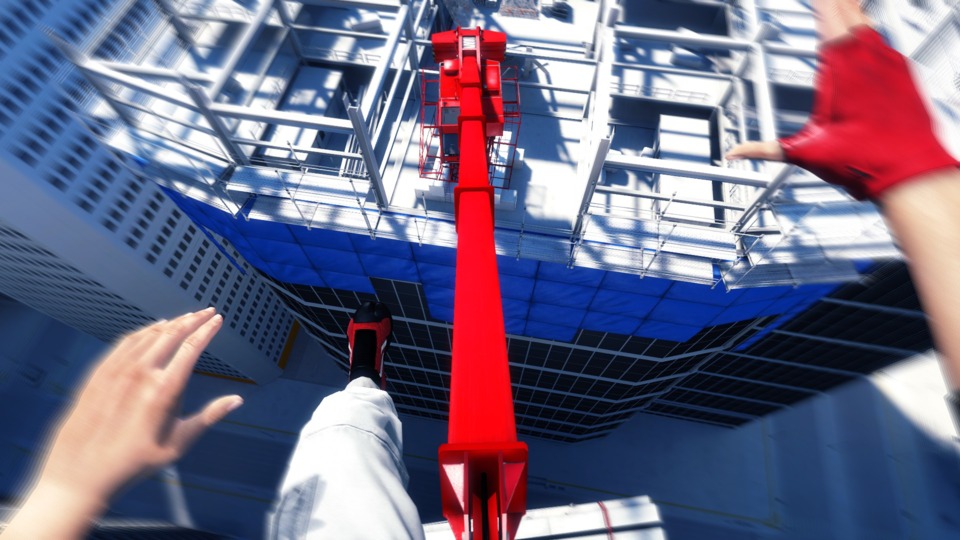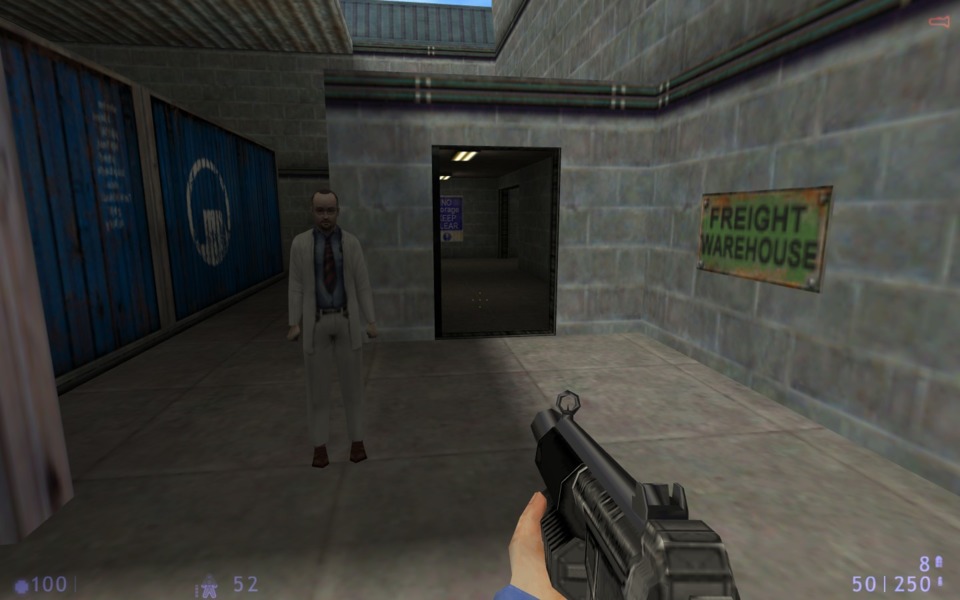High, Mid, Low: January’s Backlog Battle
By jeremyf 6 Comments
Before the flood of new releases starts up again, I took advantage of this lull period to blast away some of my troublesome backlog. I buy games faster than I finish them. However, the joyous feeling of beating games is ingrained in my psyche. I gotta do it! The three subjects of this post earned starkly tiered responses from me. It’s time to write about games everyone else has already played in High! Mid! Low!

The High: Mirror’s Edge
Mirror’s Edge had been sitting on my Xbox, installed, for quite a while. I guess it became invisible to me, or else it was never the right time to try it. When I finally booted it this month, it was on a total whim. I thought the game might fit my current mood, but I had no idea how right I would be. Mirror’s Edge hooked me almost immediately and remained a thrill ride that scarcely shows its age.
First-person platforming is rarely done well, but Mirror’s Edge is the exception that proves the rule. That starts with the intuitive control scheme. Once I internalized that the left bumper is “ascend” and the trigger is “descend,” the rest clicked into place. The button mapping is far from conventional, but it’s a good fit in the context of this game. The next pillar is the level design. The developers included a hefty number of parkour interactions. These platforming challenges feel naturalistic, yet tightly designed. One second, you’ll jump on a zipline, then you’ll drop onto a crash pad, make a running leap off a board, and grab onto a pipe. The Runner’s Vision mechanic is what makes this smooth sequence possible. Some players may dislike the “handholding” – and there’s a hard mode that turns off the red highlights – but personally, the guidance let me keep the sense of momentum. It immersed me in the fantasy of a freerunning savant. Not every moment is pain-free. Sometimes, the camera doesn’t lead the eye in the right direction, causing unnecessary confusion. Still, the batting average is shockingly high.
Most of the time, you’re either running on the rooftops or in some building. The former was my preferred environment, but it wouldn’t be as fun without spicing it up from time to time. The various locations intersect in a satisfying way over the course of a mission. More unique settings like the sewers or subway system add variety. The game's stark art style, defined by bright colors and flat detail, makes every place visually appealing. This is one of the best decisions they could have made. Compared to most other games released at the time, the graphics look great. Coupled with the smooth frame rate on backwards compatibility, it makes Mirror’s Edge feel like a modern title. That feeling is reinforced because new releases are still cribbing from this aesthetic. And why shouldn’t they? It’s iconic!
From reputation, I know that people are iffy on the game’s combat sections. I didn’t find them to be awful. Sure, they’re stiff compared to the rest of the gameplay. On the other hand, I think it’s important to have Faith actively fight against her foes rather than running away all the time. There was one section I did have to keep repeating over and over. That, though, was almost entirely due to my own impatience. And it kept playing the very best song in the game, so at least I had that. The story of Mirror’s Edge is not the most well-thought, but it is serviceable. They set up every chapter well. Faith and her radio buddy are sure to explain that they need to find such and such person or get to whatever location. This makes the levels motivated beyond an abstract obstacle course. It's a small thing, but one where a lot of games falter. When you drill deeper into silly things like character motivation and people… being where they are? Does it make sense? Uh… Listen, when certain people appeared on screen, my brain clocked, “they are going to betray us.” And when it was proven right, it didn’t really pay attention to the details.
I thought Mirror’s Edge was an excellent playthrough. I was quickly kicking myself for not trying it earlier. But now that I have, I’m still impressed with how strong of a first swing it is. This should have been a much bigger IP. I know everyone on the internet seems to agree. But we can’t have everything, so we’ll throw it onto the Sleeping Dogs pile of sadness.
What’s Next: I do have the follow-up, Mirror’s Edge: Catalyst, because it was like three bucks recently. I have pretty measured expectations for it. To be honest, I quite enjoy middling open worlds from time to time. I’ll either play that or finally try Neon White.

The Mid: Half-Life: Blue Shift
This is the second of two expansions for Valve’s medium-defining FPS. It’s considered the lesser of the two, but I played it first because I’m the type of person that eats vegetables before anything else. Blue Shift is a side story to the original campaign, tasking you with dinking around even more of the Black Mesa facility. It occupies more space than some countries. Blue Shift is unfortunately a case of been there, done that. You go through all-new level design, but the ambiance is very familiar to the original game. I was always hoping for something new or exciting to justify the five-hour runtime, but nothing tipped it over the edge.
Much of the lacking excitement comes from the expansion’s framing. Gordon Freeman is uncannily good with weapons, and he’s literally worshipped as a savior, but you have to remind yourself that he’s Just Some Guy. Barney, then, is at least 300% more Just Some Guy than Freeman. Anything you do as Barney is necessarily less cool than the first Half-Life. I understand that Gearbox wasn’t about to step on Valve’s toes too much, but it’s not a great concept for a fun expansion. There are no new weapons or enemies to experiment with. No environmental interactions tickled my fancy. All I remember is an aggravating elevator puzzle.
That moment was the only truly frustrating one, I must stress. No high-octane moment is enough to tear your hair out. It’s still Half-Life, so the shooting is solid. There are noteworthy set pieces, even if the overall momentum is inconsistent. Blue Shift is fine. It’s just not essential by a long shot. I know I’m probably the last person to add the Half-Life series to their Steam account. Still, I found plenty of things to latch onto when I played the original some years ago. That was absent in Blue Shift. It’s got a mercenary feeling, made from mostly old assets for a quick buck. We see this type of DLC all the time today, so it’s not that surprising. And I certainly can’t be mad at Valve over this when I can load the rest of my unfinished games onto the Steam Deck and glue myself to it.
What’s Next: Well, there’s still Opposing Force. In essence, the series only goes up from here. I don’t know when I’ll find time to fit it in, but maybe one of these years.
The Low: Hitman: Codename 47

Playing Hitman: Codename 47 today is like going back in time to meet your significant other as a shitty teen. Part of you is horrified that this could be the same person you know. Another part is almost proud of them for maturing so much. Even in the best light, you’re still stuck with an awful version of a person redeemed only by the fact that they will eventually grow into someone you like.
Let me rewind. I jumped onto the Hitman franchise with the World of Assassination soft reboot. It quickly became one of my favorites to return to over and over. Through the eventual trilogy’s highs and lows, IO refined a sandbox where goofing off and masterful play are equally fun. But I had assumed that the gameplay in the reboot was pretty much the same as the preceding titles. It’s why I scooped those games up in a Steam sale years ago. But if we look at the evolutionary timeline, with a fully formed Hit-human on one side, the 2000 release is closer to fish than ape.
Over my many hours with Hitman, I identified the three elements that make a successful level. I want to 1) Explore an exotic and appealing location where I can 2) kill a charismatic target in 3) memorably varied ways. Codename 47 comes up short in each of these criteria. Where locations are concerned, there’s nothing more exciting than typical video game fare. These 23-year-old PC graphics don’t do any favors whatsoever. Assassination targets are painfully basic, and the methods available to you are scant compared to what modern players expect. Every time I tried to play the game as a sandbox, I was slapped in the face and put in time-out.
I tried as hard as I could, but I could find no way to play Codename 47 stealthily. The biggest culture shock is that there’s no way to interact with NPCs nonlethally. I’ve lured countless waiters into bathrooms to steal their clothes in my time. Here, though, you need a bullet or fiber wire to do the job. When I’m used to minimizing casualties outside of the targets, it feels wrong. The detection system here is set off by a hair’s breadth. If the poor waiter makes too much noise as they collapse, you’ll find a small army of guards ready to mow you down in 2.3 seconds. Even when you’ve got your disguise, taking the wrong step or doing required actions will bring the same result. Often, guards will be stationed outside of a door you need to enter. There’s not coin in this game to get them out of the way. If you walk in, they shoot. If you shoot, everyone else will shoot. It’s a no-win scenario. And some aspects of a mission are randomized every try, so you can never truly get comfortable. The death knell of this whole system, though, is the total absence of mid-mission saving. Fail at the very last moment, as I did numerous times? Back to the very beginning and the bathroom. Am I a pampered modern stealth player? I seriously don’t care if you label me so, but you have to try it yourself first. The merciless punishment for failure totally disincentivized any will to experiment… or even to play fair.
I first tried Hitman: Codename 47 two years ago. I struggled through the early missions setting up the first actual assassination. Once I finally got there, I rapidly lost my mind. I became furious at the game’s draconian systems, so far removed from what I knew. Traveling to the target’s hideout only rewarded me with bullet holes. I went through a lot of difficulty repeatedly trying to accomplish the secondary objective, stealing a jade statue and delivering it to a tired racial stereotype. He rewarded me with poison for the target’s meal, which triggered the target and his giant enforcer to enter stage left. I hurriedly donned a waiter outfit and poisoned the food. I was rubbing my hands together when the enforcer unexpectedly taste-tested it for him, keeling over. And then the bullet holes arrived all the same. I was livid that all that progress was thrown away in seconds due to something I couldn’t possibly have seen coming. That was it. I rage quit.
Then, in 2023, I decided that it was time to revisit Codename 47. Don’t get me wrong, I had no intention of playing by the game’s rules anymore. One google of console commands later, and I was an invincible and invisible killing machine running past any possible opposition. What I saw was not encouraging. Following the restaurant level is a needlessly gargantuan jungle you must run between for minutes on end. No cheat can speed that up. The next target was a drug lord whose only personality was spouting lines from (I assume) Scarface. The humorous thing about my cheats was that alerted guards would follow 47 around with their guns pointed, but powerless to actually pull the trigger. I streaked through an assembly of world leaders at a big hotel, a location that held the most promise for a modern reinterpretation of the game. I endured some seriously painful missions at a dark port, where auto-fail conditions punished me regardless of immortality. The game crashed a lot, but considering it was never designed for modern hardware, I’m amazed it managed to hold together at all. Finally, I returned to the asylum where 47 completed the tutorial mission. Because of my… advantages, I felt that this was a fitting climax and an improvement on the rest of the game. While the earlier targets are weak, they at least tie together with the doctor that created 47. You hear him rant at his creation all through the tutorial, so there’s an actual connection with the guy when the time comes to shut him up. There’s drama when 47 walks into his trap, even as I wept for any remaining legitimate players. The events of the first game are still referenced and important to the modern series, albeit retconned heavily. I’m glad I could at least experience them firsthand, even if it’s largely a disaster.
What’s next: Okay, I’m dimly aware that some of Codename 47’s missions were remade in Hitman: Contracts. But they need to pull a Last of Us and remake the remake if they want people to get the context. And, like, make it less gross. As for me, I’m all in. I need to find out when this series gets fun. But first, I’m looking forward to the new mode coming to Hitman 3. That should be the ultimate palette cleanser.
